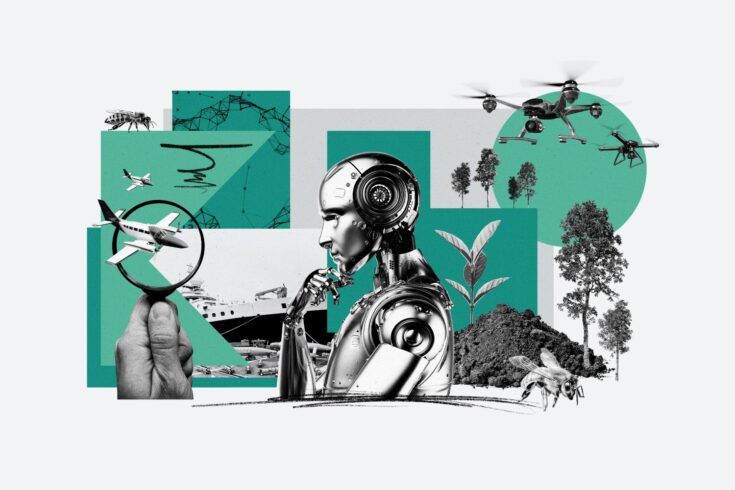I speak for most people at the Natural Environment Research Council (NERC) when I say I joined the organisation not simply because I have an affinity for the environment but because I want an active role in highlighting the challenges it faces.
Environmental monitoring is key to that protection. You need evidence to understand the big challenges such as global warming, poor air quality, river and sea pollution and a decline in biodiversity.
It helps us to form objective scientific perspectives on natural processes and the risks and threats facing the environment and how they can be addressed.
New technologies, such as artificial intelligence (AI), quantum sensing and the internet of things, are opportunities to do this monitoring better and in real time so we, as individuals, organisations and businesses, can act quicker and more effectively.
At the same time, the environmental monitoring sector must ensure that the way we operate does not damage the environment we love. This is particularly so when we consider its carbon footprint.
Collecting data in a sustainable way
We own ships and planes and lots of large infrastructure that are responsible for monitoring the environment. They generate around 73% of NERC’s total carbon footprint.
UK Research and Innovation aims to be net zero by 2040. That means we must rethink our digital research infrastructure and monitoring approaches.
We are already using AI to optimise route-planning for our ships and testing alternative lower carbon fuels. More broadly, we are looking at what the future of environmental data collection might look like with fewer large pieces of infrastructure.
Future will be autonomous
That future will be autonomous, and will move away from large single-purpose bits of kit to using technologies that are more adaptable.
For example, we are looking at the use of unmanned aerial vehicles like drones to look at how we can capture atmospheric data.
On the oceans, we’re likely to switch to smaller autonomous vehicles that could, for example, dock with a larger vessel. Our Future Marine Research Infrastructure programme is working with the scientific and business community on developing the best ideas for the future.
Change is likely to look different terrestrially where environmental monitoring networks are already quite distributed. What we will see is much more AI and data science.
Funding opportunity seeks new ideas
We’re about to launch a new funding opportunity, working with our colleagues at Innovate UK and the Department for Environment, Food and Rural Affairs (Defra). It seeks applications looking at how we can apply some of these new technologies to environmental monitoring.
It’s targeting priority policy areas for Defra, including biodiversity and natural capital, soil health, water quality and monitoring of greenhouse gas emissions.
We want applicants to look at how they can apply new technologies and innovation to both capture of environmental data and to making existing monitoring systems work more effectively. We’re quite agnostic about the solutions people will deliver.
AI is helping to protect caribou
I’ve been impressed by how AI is making a difference to a project involving our British Antarctic Survey in the Canadian Arctic.
They are combining satellite observations with GPS tracking of caribou, AI forecasting and local knowledge to predict the animal’s movements.
It’s helping scientists to predict when migrating animals are likely to cross the ice so they can impose timely restrictions on human activity such as ship movements and ice-breaking.
Building a digital twin of Earth
One of the biggest changes of my working life has been the inexorable digitalisation of environmental science. I am of the pre-internet generation so I’ve lived through this.
We have problems associated with understanding complex systems that are difficult to solve and where we sometimes can’t see the wood for the trees. We need new digital techniques to look at things such as causality. They are already delivering insights that we wouldn’t have been capable of a few years ago.
I’m excited by initiatives such as the EU’s DestinE, or Destination Earth, project. It aims to build a full digital twin of the Earth by 2030. It’s hugely ambitious and complex and involves a large amount of digital infrastructure. It will be capable of monitoring, simulating and predicting the interaction between natural phenomena and human activities, such as floods, forest fires, and all manner of environmental impacts. It will also connect with different disciplines so we can make insightful policy decisions.
Data collections can be a patchwork quilt
Environmental data can be something of a patchwork quilt. You get lots of insight at a certain time and in a certain place but no insight at another time in another place, depending on the framing of the data collection and the research itself. Access to this data may require the use of niche software.
How you approach that data and make it as accessible and interoperable as possible is an ongoing challenge for us.
We hold tens and tens of petabytes of environmental data in lots of different areas. It’s a bit like walking into a huge library and saying ‘what book should I pull off the shelf’. You need some guidance.
We want our data to be actively used
I did a doctorate in tree physiology, looking at the impacts of climate change on issues such as canopy structure and leaf development for the Forestry Commission. It was research with a strong practical application.
That desire to have a practical impact has continued to motivate me in a career that first saw me working in the field for the Environment Agency and now at NERC.
We don’t want to simply curate data in a dusty library. NERC wants it to be actively used, and this is where digital technology will bring more change.
We are starting to manage more streaming data, where the user can see the data as it is gathered live. We are looking at more interoperable data that can be combined with other sources. Combine environmental data with health data and you suddenly get a whole new set of data products that are really valuable.
If you can use technology to provide integrated information in a timely way that allows for policy interventions, you have something of great value that can hugely benefit society.




